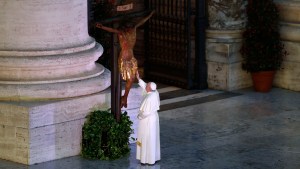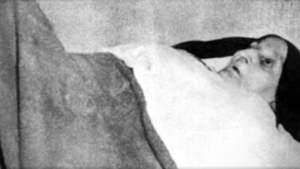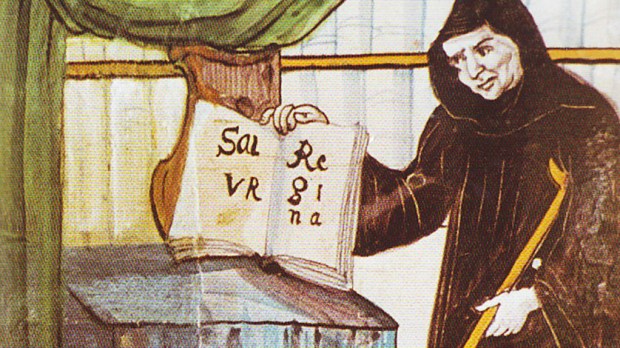Though most saints are depicted as relatively young, slim, and physically able in sacred art, there are many disabled saints who found holiness not in spite of their disabilities but in and through them. While many used wheelchairs in their old age (including St. Josephine Bakhita, St. Marianne Cope, St. Laura Montoya, and St. Mary Mackillop), others were disabled all their lives, or developed their disabilities in their youth. Saints with mobility impairments stand as witnesses of holiness, offering a model not just for disabled people but for all who seek to follow Jesus.
Blessed Hermann of Reichenau (1013-1054) was known as the wonder of his age. Historians believe that he was born with a cleft palate and cerebral palsy, in addition to either spina bifida or spinal muscular atrophy. Whatever the underlying condition, Hermann was never able to walk. Since he lived before the invention of wheelchairs, he had to be carried from one room to another by the other monks in his German monastery. In his cell, he sat in a special chair constructed to make his intellectual labor possible. There, Hermann studied math, astronomy, history, and theology. He constructed the first astrolabe in Europe, wrote a history of the first Christian millennium, and (after going blind) began composing music. Many believe that we owe the Salve Regina and the Alma Redemptoris Mater to Hermann, all before he died at only 40.
Blessed Margaret of Castello (1287-1320) was born with kyphosis (or a hunchback). That, combined with her legs of differing lengths, her small stature, and her blindness, was more than enough to make walking quite difficult for the little noblewoman, who used a crutch all her life. But her disability was no tragedy; the tragedy lay in her noble parents’ rejection of their daughter, whom they saw as imperfect and undesirable. After hiding her away for years, they abandoned her in a town where she knew nobody. Margaret forgave her heartless parents. She forgave the nuns who welcomed her into their convent and then expelled her when her gentle holiness exposed their lazy sinfulness. She spent the rest of her life living on the generosity of others, all of whom understood that by her joy and her wisdom, Margaret gave them far more than they gave her.

Read more:
Confined at home, let us take up 2 things, says pope: the Crucifix and the Gospel
Blessed Alexius Kim Si-u (1782-1815) was a gentle and intelligent Korean nobleman. He was also paralyzed on the right side of his body. Cultural norms at the time made it impossible for him to marry; his disability made it very difficult for him to work. But nothing prevented him from preaching the Gospel, to non-believers and to other Catholics, who were grateful for his learning in a time when there were no priests in Korea. Alexius copied and sold religious books to support himself but was often financially supported by the Christian community as well. When police arrested all the Catholics in the village except Alexius, he protested this special treatment. “I am also a Catholic,” he insisted. “Why don`t you arrest me? Is it because I am disabled?” The police arrested him, too, and took him to a prison where he evangelized so incessantly that the governor ordered his jaw broken to silence him. Alexius was unable to earn money for food as the other prisoners did (through making straw shoes) and starved to death at the age of 33.
Servant of God Eileen Rosaline O’Connor (1892-1921) broke her spine in an accident as a toddler; she was never able to walk again, experienced excruciating pain all her life, and was 3’9” at her tallest. At only 20, she founded the Society of Our Lady’s Nurses for the Poor, an order dedicated to providing free nursing services to the poor in their homes. Eileen was a tremendous leader, in spite of the many defections the order experienced in its early days. Her success was marred by false allegations of impropriety between her and Fr. Edward McGrath, who had founded the order with her. Though the allegations were proven to be untrue, Eileen was left to run the order alone until she died at 28.

Read more:
57 years with her legs bent in ‘crucified’ position: Meet Mariantonia Sama
Servant of God Darwin Ramos (1994-2012) was the son of an unemployed alcoholic. The oldest of eight children living in the slums of Manila, Darwin had no opportunity to go to school, spending his days picking through trash. When Darwin was five, his mother took him to a clinic, complaining that he seemed weak. Though the doctor dismissed the impoverished woman, insisting that the child was just malnourished, Darwin would later be diagnosed with Duchenne muscular dystrophy. Soon Darwin was unable to walk; his father set him up to beg, though Darwin was ashamed to present himself as someone to be pitied. When he was 11, he was invited to move into a home for disabled street children. There, Darwin was known for his radiant smile and his spiritual leadership. Darwin saw muscular dystrophy as his “mission for Jesus.” He didn’t experience joy in spite of his disability, but because of it, insisting that the purpose of his condition was “for me to know God better and to trust him better.” He died at 17 of complications from muscular dystrophy.

Read more:
She wasn’t born a saint, but became one day by day: Rome launches cause for Chiara Corbella

